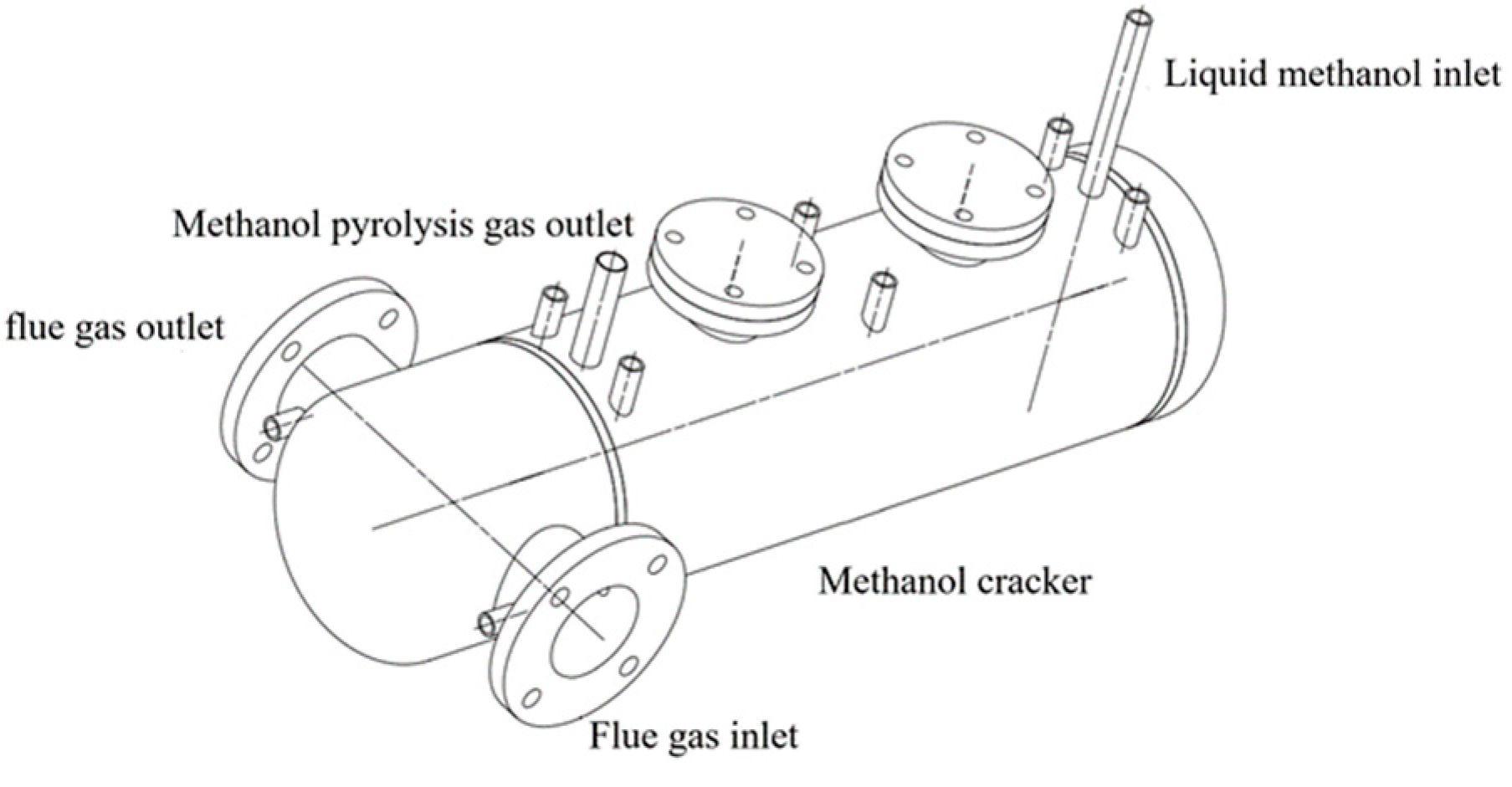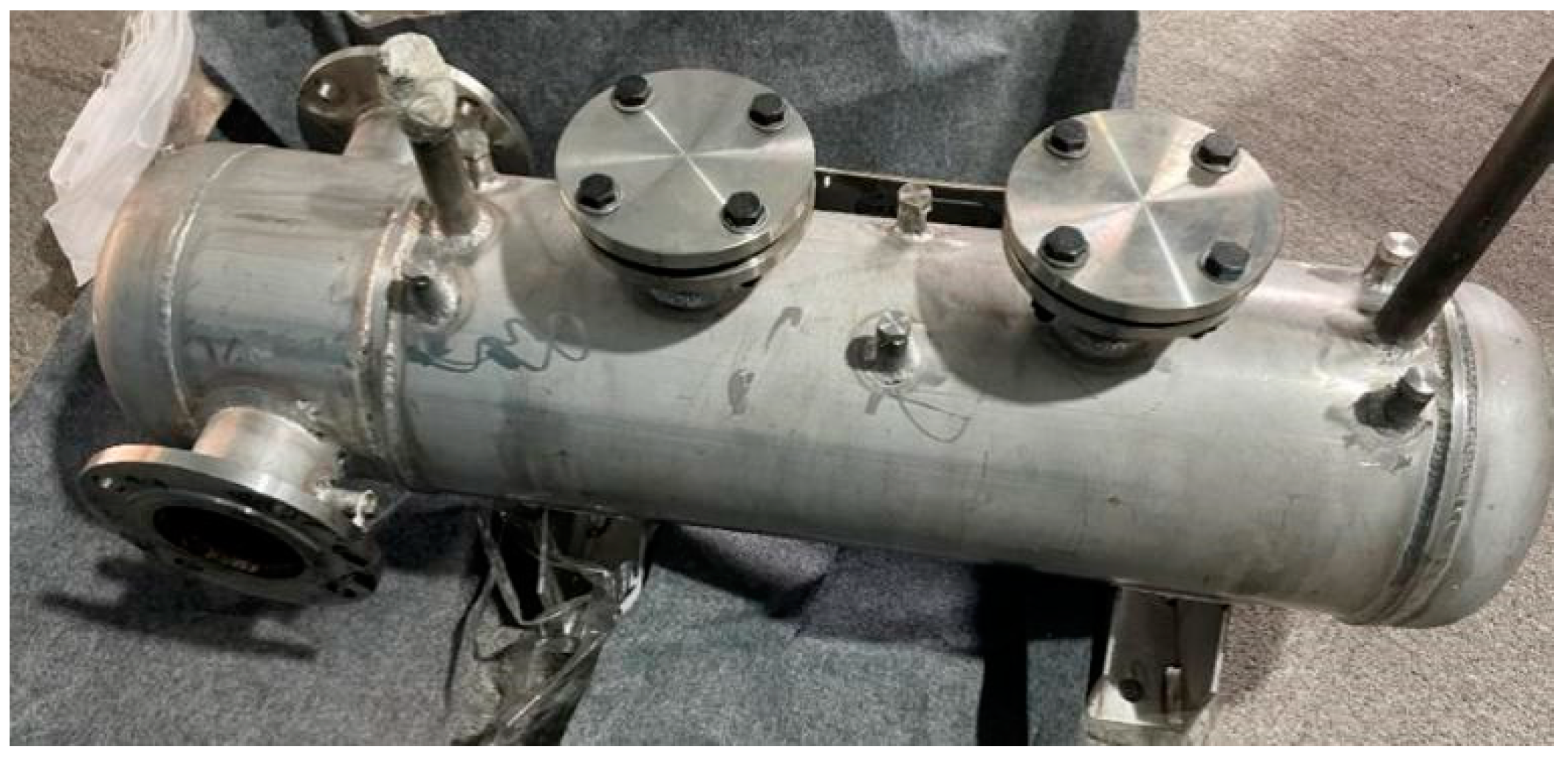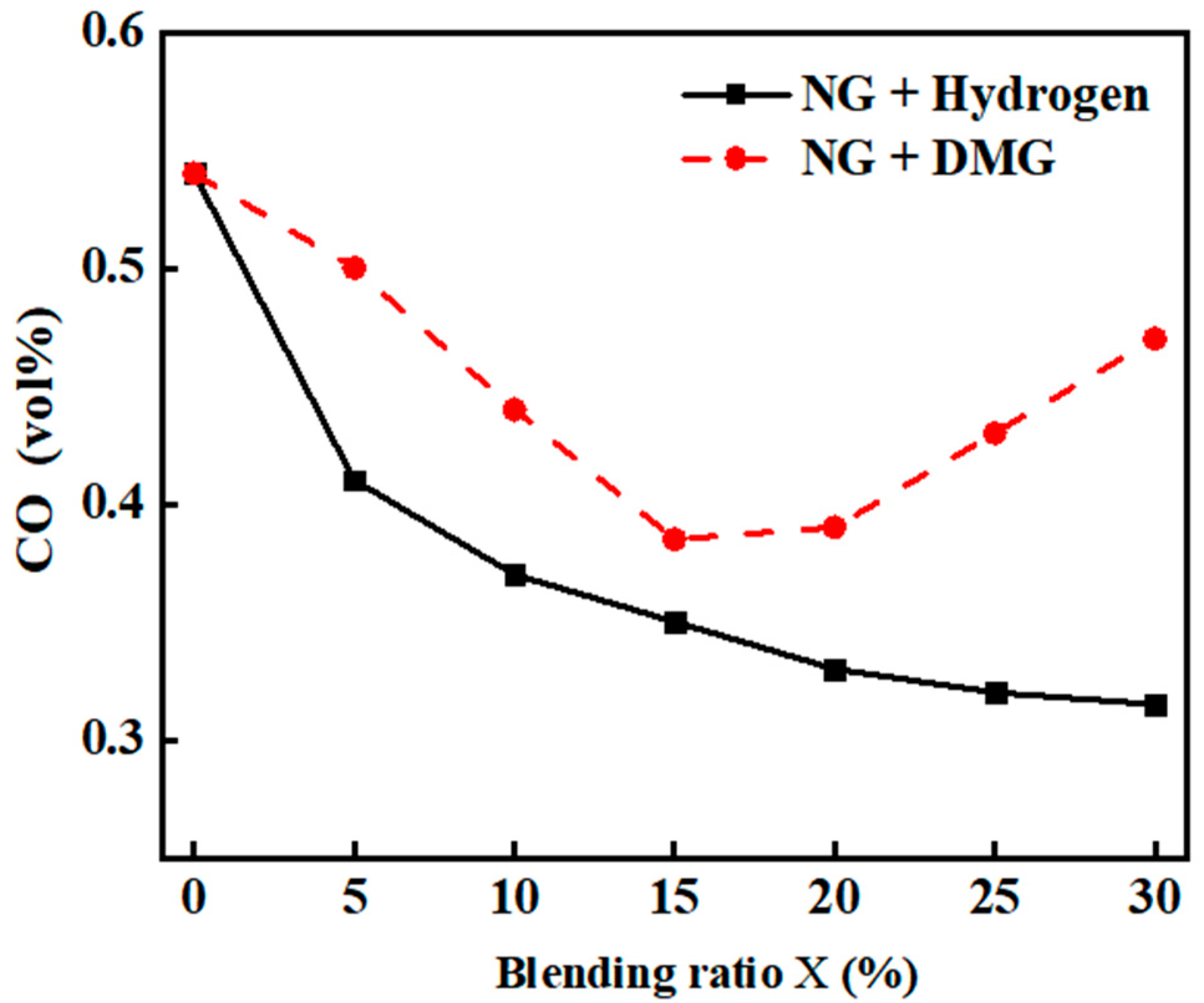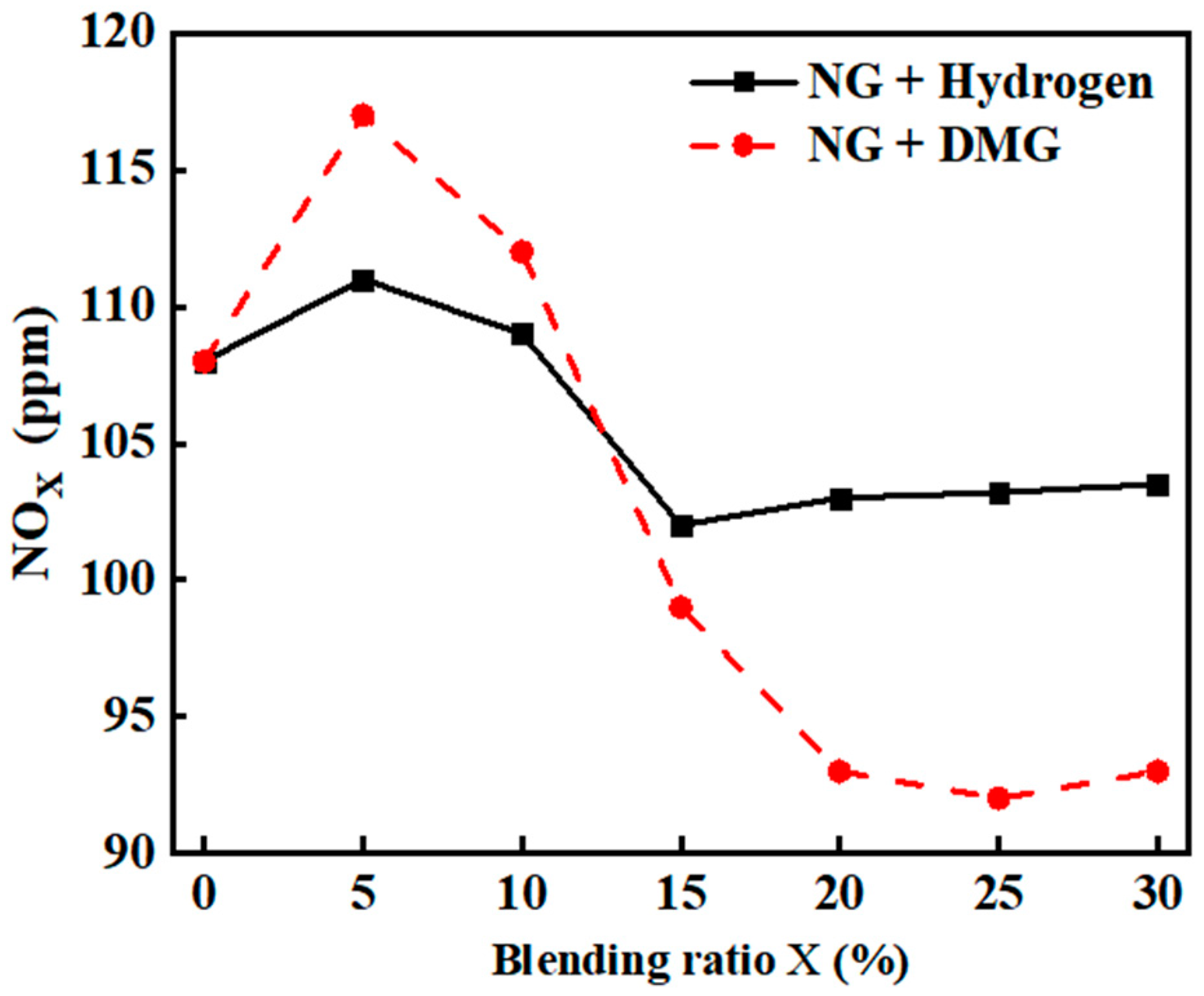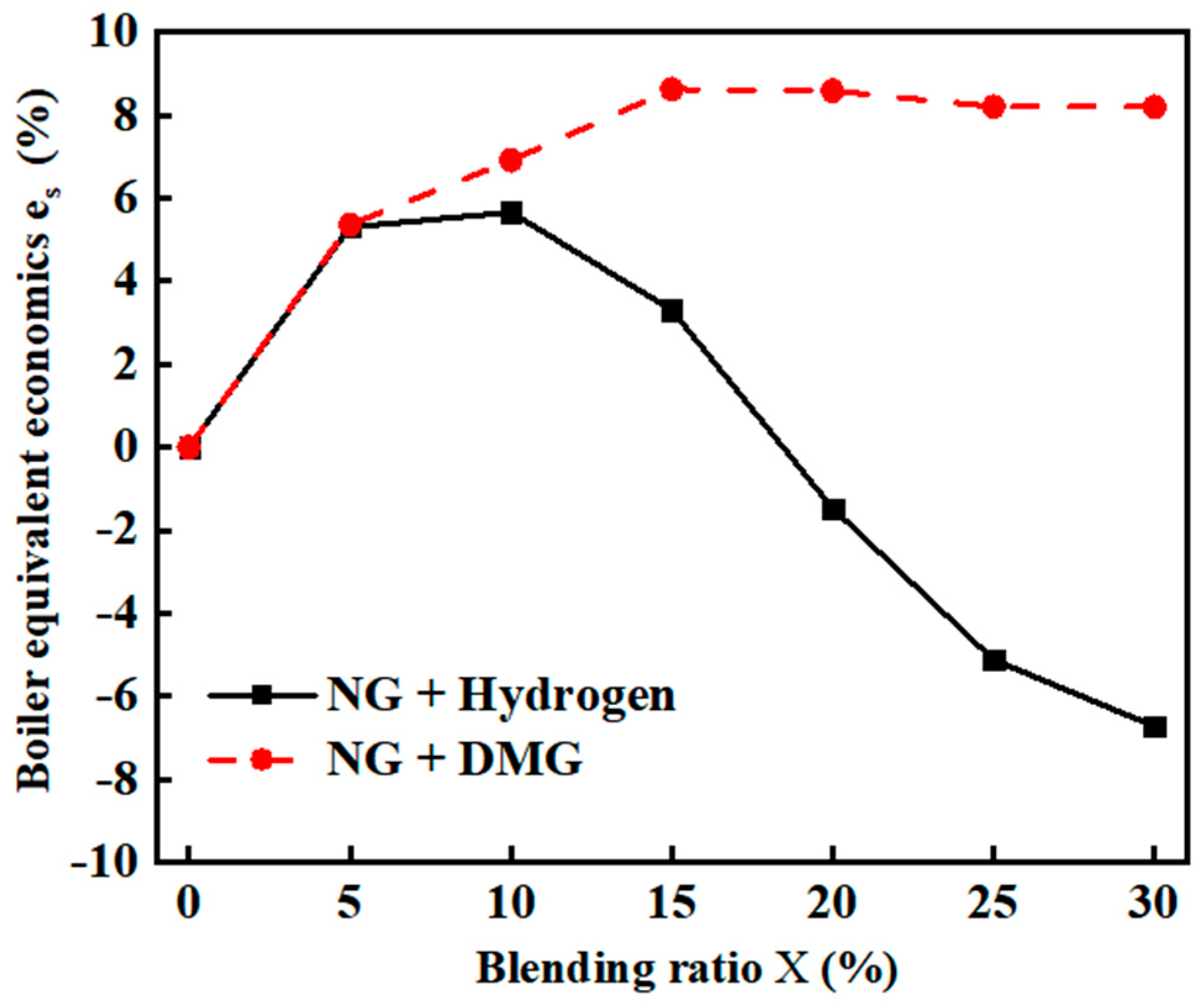The excess air coefficient was controlled at 1.2 while maintaining the total volume flow rate of the mixed fuel gas at 10 m3/h under different blending ratios. The thermal efficiency, emission indicators, and economic performance were analyzed accordingly. The blending ratios of hydrogen and DMG in the mixed gas were 5%, 10%, 15%, 20%, 25%, and 30%.
3.1.1. The Impact on Boiler Thermal Efficiency
Boiler thermal efficiency is a key indicator for assessing the energy utilization efficiency of a boiler [
19]. The effects of the blending ratios of hydrogen and DMG on thermal efficiency are shown in
Figure 7. The related data are shown in
Table 4. From the figure, it can be observed that as the hydrogen blending ratio increases, the boiler’s thermal efficiency (
first rises and then decreases. When the hydrogen blending ratio reaches 10%, the thermal efficiency (
peaks at 66.57%. Hydrogen burns faster than natural gas (NG), with a higher flame temperature. When the hydrogen blending ratio with NG ranges from 0% to 10%, it promotes overall combustion and heat transfer, thereby enhancing thermal efficiency (
. However, as the hydrogen blending ratio continues to increase, thermal efficiency (
declines. This is because hydrogen has a much lower density than air, which increases the relative density difference between the mixed fuel and air. This disparity may lead to fuel stratification, which can prevent sufficient mixing of oxygen with NG, resulting in localized oxygen deficiency or fuel excess, thus affecting the combustion process [
20].
As the blending ratio of DMG with NG increases, the thermal efficiency initially rises and then declines. It reaches its maximum value of 66.04% when the blending ratio is 15%. This phenomenon occurs because, at lower blending ratios, hydrogen and CO facilitate the combustion of NG. However, as the blending ratio increases and the proportion of hydrogen rises, the combustion quality deteriorates, leading to a decrease in thermal efficiency. Nevertheless, compared to the declining trend observed with hydrogen blending, the reduction is relatively smaller.
Overall, hydrogen has a more significant catalytic effect on NG combustion. Therefore, when hydrogen is blended with NG, the thermal efficiency improvement is greater than when DMG is mixed. In contrast, as the density of DMG is higher than that of hydrogen, its impact on the relative density difference between the mixed fuel and air is less significant. As a result, when DMG is blended with NG, the thermal efficiency increases before stabilizing, showing a smoother fluctuation.
3.1.2. The Impact on Boiler Emissions
The impacts of the blending ratios of hydrogen and DMG on CO emissions are shown in
Figure 8. The related data are shown in
Table 5. From the figure, it is evident that as the hydrogen blending ratio increases, CO emissions gradually decrease, particularly with a noticeable reduction at low blending ratios, while the decline becomes more gradual at higher blending ratios. This phenomenon is primarily attributed to hydrogen’s lack of carbon, which reduces the overall carbon content of the input fuel. A small amount of hydrogen effectively promotes the combustion of NG, reducing the formation of incomplete combustion products such as CO, leading to a significant reduction in CO emissions initially. However, when the hydrogen proportion is too high, the increased relative density difference between hydrogen and air, coupled with the faster flame propagation speed, may cause flame stratification. This stratification may prevent oxygen from mixing sufficiently with NG, resulting in incomplete combustion and a rise in CO production. Therefore, despite the overall reduction in the carbon content of the input fuel, CO emissions tend to level off as the hydrogen proportion becomes too high.
In contrast to hydrogen, DMG contains a higher carbon content. Although its carbon content is lower than that of NG, it still contributes to the overall carbon content. Consequently, when DMG is blended, the overall carbon content of the input fuel decreases, leading to a general decline in CO emissions. However, as DMG itself contains CO, the combustion deterioration at higher blending ratios may lead to an increase in CO emissions, causing CO emissions to follow a trend of initially decreasing and then increasing.
The impacts of the blending ratios of hydrogen and DMG on CO
2 emissions are shown in
Figure 9. The related data are shown in
Table 6. As can be seen from the figure, both the incorporation of hydrogen and DMG resulted in a reduction in boiler CO
2 emissions. The primary reason for this phenomenon is that hydrogen contains no carbon, thereby lowering the overall carbon content of the input fuel.
At lower hydrogen blending ratios, the addition of a small amount of hydrogen effectively promotes the combustion of NG, improving combustion efficiency and leading to an increase in CO2 production. Consequently, the reduction in CO2 emissions is initially slow. However, when the hydrogen blending ratio becomes too high, the combustion of the mixed fuel deteriorates, and the combustion products are not fully converted into CO2, causing a more rapid decrease in CO2 emissions in the later stages.
In comparison to hydrogen, DMG contains more carbon, although its carbon content remains lower than that of NG. Therefore, after blending, the overall carbon content of the input fuel decreases, leading to a general decline in CO2 emissions. However, as DMG itself contains CO, at low blending ratios, its promotion of combustion may cause a slight increase in CO2, resulting in CO2 emissions initially rising and then falling.
The effects of hydrogen and DMG blending ratios on HC emissions are illustrated in
Figure 10. The related data are shown in
Table 7. From the graph, it is evident that as the blending ratio increases, the combustion of NG with hydrogen and DMG results in a decrease in HC emissions followed by an increase. At a blending ratio of 15%, HC emissions reach their respective minimum values of 13 ppm and 7 ppm.
This phenomenon can be attributed to the fact that, at lower blending ratios, hydrogen and DMG help to promote the complete oxidation of NG, thereby reducing HC formation. However, as the blending ratio of hydrogen and DMG increases, their lower densities increase the relative density difference between the mixed fuel and air, leading to a faster flame propagation rate and the occurrence of flame stratification. This stratification phenomenon may prevent sufficient mixing of oxygen with NG, causing localized incomplete combustion and, ultimately, an increase in HC emissions.
Overall, at lower blending ratios, the effects of hydrogen and DMG on HC emissions are similar. However, at higher blending ratios, DMG exhibits a more significant suppression effect on HC emissions, when compared to hydrogen. This is primarily because hydrogen has a lower density than DMG, making flame stratification more pronounced, whereas DMG’s higher density results in a relatively stable combustion process when blended.
NOx, primarily consisting of NO and NO
2, is a key component in the formation of photochemical smog and acid rain. Its conversion into nitrates contributes to the eutrophication of water bodies, adversely affecting human health and the ecological environment [
21]. The impacts of hydrogen and DMG blending ratios on NOx emissions are shown in
Figure 11. The related data are shown in
Table 8. From the graph, it is evident that the incorporation of hydrogen and DMG caused the NOx emissions of the boiler to first increase and then decrease. At a blending ratio of 5%, the NOx emissions peaked, reaching values of 111 ppm and 117 ppm, respectively.
The cause of this phenomenon is as follows: when the blending ratio of hydrogen and DMG is low, both contribute to promoting the oxidation combustion of NG, increasing the flame temperature. Hydrogen, with its inherently high adiabatic flame temperature, further elevates the flame temperature, and the high-temperature, oxygen-rich environment fosters the formation of NOx. Therefore, at low blending ratios, NOx emissions increase.
Among these two gases, DMG has a higher volumetric calorific value than hydrogen. Therefore, under the same fuel volume flow rate, when DMG is blended, the total heat input to the furnace will be greater than when hydrogen is mixed. This implies that blending DMG, compared to blending hydrogen, results in a higher overall heat input to the furnace, triggering a more intense combustion reaction, further raising the flame temperature and promoting the formation of NOx. As a result, the increase in NOx emissions when blending DMG is more pronounced than when blending hydrogen.
When the hydrogen blending ratio ranges between 5% and 15% and the DMG blending ratio falls between 5% and 25%, the relative density difference between the mixed fuel and air increases, resulting in a faster flame propagation speed and the occurrence of flame stratification. This stratification may prevent oxygen from fully mixing with the fuel, leading to localized oxygen-deficient or oxygen-rich combustion. Consequently, the combustion process deteriorates, reducing the heat release and lowering NOx emissions.
When the hydrogen blending ratio exceeded 15% and the DMG blending ratio exceeded 25%, the phenomenon of flame stratification became more pronounced, leading to localized oxygen enrichment. Hydrogen preferentially reacts with oxygen, creating a high-temperature, oxygen-rich environment. Although the heat release from combustion decreased, there was a tendency for NOx emissions to rise.

